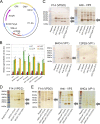Foot-and-Mouth Disease (FMD) Virus 3C Protease Mutant L127P: Implications for FMD Vaccine Development
- PMID: 28878081
- PMCID: PMC5660475
- DOI: 10.1128/JVI.00924-17
Foot-and-Mouth Disease (FMD) Virus 3C Protease Mutant L127P: Implications for FMD Vaccine Development
Abstract
The foot-and-mouth disease virus (FMDV) afflicts livestock in more than 80 countries, limiting food production and global trade. Production of foot-and-mouth disease (FMD) vaccines requires cytosolic expression of the FMDV 3C protease to cleave the P1 polyprotein into mature capsid proteins, but the FMDV 3C protease is toxic to host cells. To identify less-toxic isoforms of the FMDV 3C protease, we screened 3C mutants for increased transgene output in comparison to wild-type 3C using a Gaussia luciferase reporter system. The novel point mutation 3C(L127P) increased yields of recombinant FMDV subunit proteins in mammalian and bacterial cells expressing P1-3C transgenes and retained the ability to process P1 polyproteins from multiple FMDV serotypes. The 3C(L127P) mutant produced crystalline arrays of FMDV-like particles in mammalian and bacterial cells, potentially providing a practical method of rapid, inexpensive FMD vaccine production in bacteria.IMPORTANCE The mutant FMDV 3C protease L127P significantly increased yields of recombinant FMDV subunit antigens and produced virus-like particles in mammalian and bacterial cells. The L127P mutation represents a novel advancement for economical FMD vaccine production.
Keywords: 3C protease; Escherichia coli; Gaussia luciferase; StopGo translation; VLP; adenoviruses; foot-and-mouth disease virus; in vivo; in vivo expression technology; translational interrupter; vaccines; virus-like particles.
Copyright © 2017 Puckette et al.
Figures








References
-
- Schutta C, Barrera J, Pisano M, Zsak L, Grubman MJ, Mayr GA, Moraes MP, Kamicker BJ, Brake DA, Ettyreddy D, Brough DE, Butman BT, Neilan JG. 2016. Multiple efficacy studies of an adenovirus-vectored foot-and-mouth disease virus serotype A24 subunit vaccine in cattle using homologous challenge. Vaccine 34:3214–3220. doi:10.1016/j.vaccine.2015.12.018. - DOI - PubMed
MeSH terms
Substances
LinkOut - more resources
Full Text Sources
Other Literature Sources

